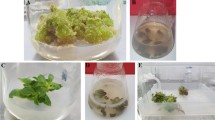Abstract
132 microorganisms, isolates from soil and decayed fruits, were tested for phytase production. All isolates intensively producing active extracellular phytase were of fungal origin. The most active fungal isolates with phytase activity were identified asAspergillus niger. At the end of the growth phase, the extracellular phytase activity produced byA. niger strain 92 was 132 nkat/mL, with strain 89 it was 53 nkat/mL. In both strains the extracellular enzyme activity exhibited two marked activity optima at pH 1.8 and 5.0 and a temperature optimum at 55°C.
Similar content being viewed by others
ReferencesReferences
Bradford M.M.: A rapid and sensitive method for the quantitation of microgram quantities of protein utilizing the principle of protein-dye binding.Anal. Biochem.72, 248–254 (1976).
Howson S.J., Davis R.P.: Production of phytate-hydrolysing enzyme by some fungi.Enzyme Microb. Technol.5, 377–383 (1983).
Irving G.C., Cosgrove D.J.: Inositol phosphate phosphatases of microbiological origin: the inositol pentaphosphate products ofAspergillus ficuum phytases.J. Bacteriol.112, 434–438 (1972).
Lambrechts C., Boze H., Moulin G., Galzy P.: Utilization of phytate by some yeasts.Biotechnol. Lett.14, 61–66 (1992).
Newman K.: Phytase: The enzyme, its origin and characteristics: Impact and potential for increasing phosphorus availability, pp. 169–177 inBiotechnology in the Feed Industry, Proc. Alltech's 7th Ann. Symp. (T.P. Lyons, Ed.). Alltech Technical Publications, Nicholasville (Kentucky) 1991.
Shieh T.R., Ware J.H.: Survey of microorganisms for the production of extracellular phytase.Appl. Microbiol.16, 1348–1351 (1968).
Simell M., Turunen M., Piironen J., Vaara T.: Feed and food applications of phytase. Lecture at3rd Meet. Industrial Applications of Enzymes, Barcelona (Spain) 1989.
Smith B.W., Roe J.H.: A photometric method for the determination α-amylase in blood and urine, with use of the starchiodine color.J. Biol. Chem. 53–59 (1949).
Ullah A.H.J., Gibson D.M.: Extracellular phytase (E.C. 3.1.3.8) fromAspergillus ficuum NRRL 3135: Purification and characterization.Prep. Biochem.17, 63–91 (1987).
Watanabe R.S., Olsen S.R.: Test of an ascorbic method for determining phosphorus in water and NaHCO3 extracts from soil.Soil. Sci. Soc. Ann. Proc.29, 677–678 (1965).
Author information
Authors and Affiliations
Rights and permissions
About this article
Cite this article
Volfová, O., Dvořáková, J., Hanzlíková, A. et al. Phytase fromAspergillus niger . Folia Microbiol 39, 481–484 (1994). https://doi.org/10.1007/BF02814066
Received:
Issue Date:
DOI: https://doi.org/10.1007/BF02814066




